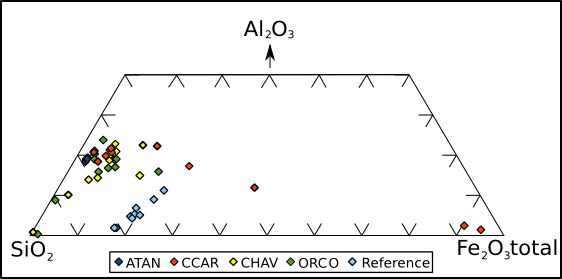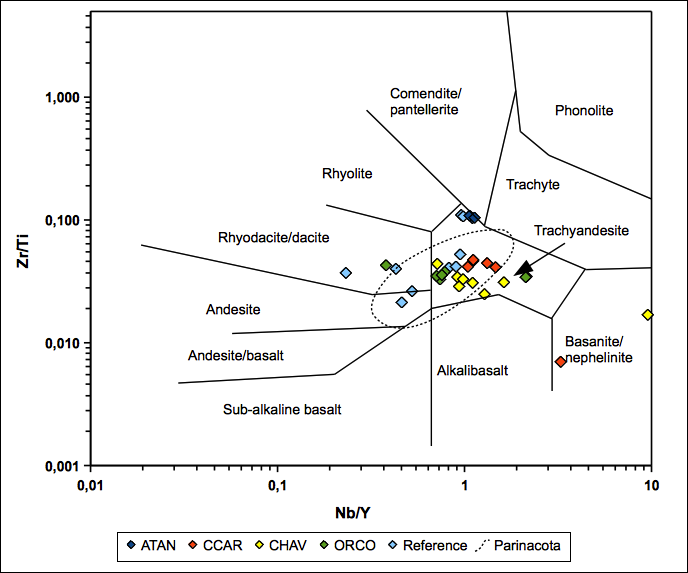
GeoPeP 2011/2012
Geochemistry results
Main elemental composition
The XRD analytic reveals SiO2, Fe2O3 and Al2O3 as the most abundant elemental components with up to 80-85 wt% in total. Exceptions are samples CCAR-11-13 and CCAR-11-14 where these oxides only make up about 65 wt %, whereas within ORCO-11-01-1 to ORCO-11-01-3 and CHAV-11-17 the total value even exceeds 90 wt%.
In the relative distribution among these three oxides SiO2 generally dominates with 60-80 %, spiking up to nearly 100 % in ORCO-11-01-1 (see fig. 2). Exceptional high Fe2O3 fractions are represented in samples CCAR-11-17 with around 40 %, reaching even 90 % in CCAR-11-13 and CCAR-11-14.

Fig.2: Ternary-Diagram showing the main elements
K2O and Na2O are the most common elements of minor abundance each with contents between 0.5 and 4 wt%. In general, Lomada Atansa samples exhibit significantly higher concentrations varying between 3 to 4 wt%. For the remaining locations, contents around 1 to 2 wt% are obtained, whereas K2O and Na2O are nearly absent in CCAR-11-13 and CCAR-11-14, plus in some Cerro Orconcchocha samples.
CaO is present in Lomada Atansa samples with 1-3 wt%, but remains well below 1 wt% in all other cases. TiO2 contents are generally around 1 wt%, in Lomada Atansa TiO2 is below 0.5 wt%. Samples CCAR-11-13 and CCAR-11-14 do not contain any TiO2, but are relative rich in sulphate with around 11 wt%. For the remaining Carhuarazo and Cerro Chavina samples, sulphate contents vary between 1-4 wt%, whereas Lomada Atansa and Cerro Orconcchocha samples do not contain any significant amounts. P2O5 and MgO are of minor importance and vary between 0 and 1 wt%. MnO is almost absent in all samples.
In general, the total amount of the elements of minor abundance makes up for 4-13 wt%, except for ORCO-11-01-1 to ORCO-11-01-3 and CHAV-11-17 which have sums around 1 wt%.
The deviation between the sum of the major and minor elemental oxides and roughly 100 wt% can be found in the loss of ignition (LOI). Usually, the LOI varies between 5-11 wt%, but makes up around 30 wt% for CCAR-11-13 and CCAR-11-14.
Trace elemental composition
REE element patterns for all locations are rather similar with respect to the LREE being relatively more enriched compared to the HREE, resulting in a smooth slightly negative trend (see fig. 3 a-d). Except for a small negative Eu anomaly in Cerro Orconcchocha samples, no outstanding deviation from this trend occurs. Samples CHAV-11-17 and ORCO-11-01-1 which are thought to be affected by massive silification, show almost no enrichment of REE or even a small depletion compared to chondrite. CCAR-11-13 and CCAR-11-14 exhibit the same overall REE pattern, but have contents one magnitude below the other Carhuarazo samples.

Fig.3: Chondrite normalized REE-patterns (Chondrite Data from Evensen et al., 1978)
Cerro Orconcchocha exhibits a distinguishable different REE pattern compared to the other locations. Aside from the Eu anomaly, the lighter REE remain in the described pattern up to Gd, from where they split up for some samples. Regarding samples ORCO-11-01-1 to ORCO-11-01-3, a correlation between SiO2 contents and the degree of REE enrichment can be observed. High concentrations of SiO2 anti-correlate with an enrichment of the heavier REE.
Classification
With respect to a classification of altered rocks according to Winchester and Floyd (1977), most samples can be assigned to a trachyandesitic composition (see fig. 4).

Fig.4: Classification of altered rocks according to Winchester and Floyd (1977)
© Christian Hansen, Andres Höweling, Kai Nitzsche, Tammo Ohlendorf 2012